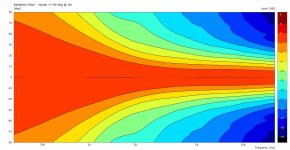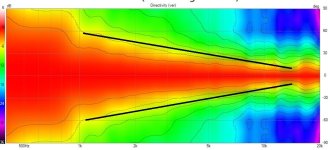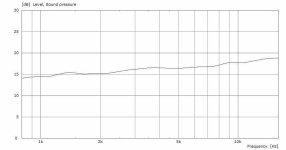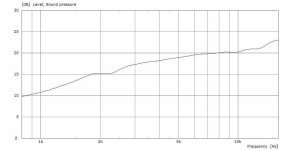I think you might be misunderstanding Art's words. When a driver has a 90 degree pattern it is beaming, the directivity of the driver has narrowed the pattern. If a driver was free of any beaming the pattern would be 180 degrees on a flat baffle. In the graphics the 416 drivers have more directivity than an equivalent flat piston. The graphics are not that easy to interpret and the scales make it hard to read off values other than the listed ones.Weltersys seems to predict that it will be free of beaming as high as 1kHz, yielding 90 degrees coverage; see posts # 185, 205. Thanks to Weltersys for this comparison.
It seems what Art was saying is that the 416 driver is not particularly narrow for a 15" driver.
That's because the Altec 416 is not pistonic beyond 500Hz. Its curved diaphragm is designed to break up gently and therefore its effective piston diameter shrinks gradually as frequency rises, making its directivity less pronounced than would be theoretically predictable for a perfect piston of its nominal diameter.
As of today, awaiting NicoB's requested vertical. impedance and other plots and/or may not get to hear his new horn in NYC within the required time frame.Regardless of choice you are going to have to work for it. I am going to go out on a limb here and say between the two it probably matters most in a smaller room - the Yuichi is reputed to perform marginally better in a small space than the TH-4001, if you are closer than 5 meters listening distance I would say that pushes you more towards the Yuichi otherwise both are reasonable.
I'd be as close as 11 ft from the front of the speakers, so the A290 instead of the TH4001? But does Troy Crowe's version provide any substantial improvement over the original A290? https://josephcrowe.com/blogs/news/smooth-transition-throat-adapter-no-2322-for-yuichi-a290 From all of the plots, it looks like performance is largely driver dependent. Driver recommendations?
Your thoughts on this? Any "drop in" drivers for the A290?I've also sort of hit a wall trying to plan the supporting midbass to the A290. I discovered that trying to mate a direct radiator to a horn further down in.frequency range is much more difficult than just tacking on a super tweeter to a smaller horn. Theres so much more to consider and go wrong working in the critical midrange around the A290s preferred crossover frequency. Anything between 300 and 1000 hz is very delicate, especially between two different types of drivers like the A290 and another direct radiating cone with abrupt directivity changes.
Last edited:
Not a drop in, but here's one Troy uses in this two way system, though a very different horn, and possibly with a contour filter for HF extension.
https://josephcrowe.com/products/speaker-system-no-1681
https://www.rcf.it/en/products/product-detail/nd350
https://josephcrowe.com/products/speaker-system-no-1681
https://www.rcf.it/en/products/product-detail/nd350
Sorry for the delay Oltos.As of today, awaiting NicoB's requested vertical. impedance and other plots and/or may not get to hear his new horn in NYC within the required time frame.
I'd be as close as 11 ft from the front of the speakers, so the A290 instead of the TH4001? But does Troy Crowe's version provide any substantial improvement over the original A290? https://josephcrowe.com/blogs/news/smooth-transition-throat-adapter-no-2322-for-yuichi-a290 From all of the plots, it looks like performance is largely driver dependent. Driver recommendations?
I apologize for the earlier confusion and can explain why my first horn was used at 700hz : The first horn was actually a 54cm one, not 44cm, it was a mistake on the website, this might explain some of the confusion. I apologize.
The horn comes in two versions: 1" and 1.4"/1.5" (with different adapter for the latter). Sizes between 48cm and 60cm can be available on a custom basis.
The website now includes the vertical polar response data for the 48cm horn. While we don't currently have the vertical data for the 54cm version, the 48cm data can provide a good starting point.
You can find more information and the 48cm vertical polar data here: https://audiohorn.net/next-gen-bi-radial-horn/
Of course if you need to cross low, choose 60cm version.
As I already expected, imo a beaming device for the vertical. It looks as if you have sacrificed vertical dispersion in favor of horizontal dispersion. It is not constant directivitity anymore for the vertical. Wrt designing such radial like horns, it is all about to get the vertical right and one single profile does not work. For me, 90% of optimization is for the vertical. And a plain radial profile is not able to provide better controlled dispersion.
What I prefer is a knee-less behavior and almost constant in the upper octaves like for my radial fin-less designs:

With an outer profile added, this figure would even look better.
What I prefer is a knee-less behavior and almost constant in the upper octaves like for my radial fin-less designs:

With an outer profile added, this figure would even look better.
What ?! I sacrificed nothing and there is no device "beaming" on vertical, it's the normal vertical behavior of biradial in vertical, show real measurement of yours instead of BEM sims... I have even more coverage of yours sims at 5khz, Your are at 40° when I'm in 50°... I offer more opening vertically.
Your beam doesn't take in account the how the driver behave when the wavelength is shorter that the throat size, is comparing orange and apple...
You make speculation on simple BEM simulation... your vertical sims will NOT behave like this in real measurement, it's acoustics basics...
Your beam doesn't take in account the how the driver behave when the wavelength is shorter that the throat size, is comparing orange and apple...
You make speculation on simple BEM simulation... your vertical sims will NOT behave like this in real measurement, it's acoustics basics...
So what's the true DI of these devices? Did either of you ever bother to actually find out? The only mention I see on Nico's web is that it's a "Constant Directivity" and that it has "a flat Directivity Index (DI)", which is obviously nonsense.
I would expect it won't be so bad, after all, but never saw it actually presented, comprising all the (spherical) data, not just a chosen single plane, which is obviously not enough for these highly asymmetric devices. For a true DI you need the true total radiated power (that actually matters a lot in a room).
I would expect it won't be so bad, after all, but never saw it actually presented, comprising all the (spherical) data, not just a chosen single plane, which is obviously not enough for these highly asymmetric devices. For a true DI you need the true total radiated power (that actually matters a lot in a room).
Last edited:
If your simulations don't match the reality well, you must be doing it wrong 😉You make speculation on simple BEM simulation... your vertical sims will NOT behave like this in real measurement, it's acoustics basics...
Ho, you right, I refactor to fast it’s constant horizontally "only" so yes no flat DI of course
They match in FEA, there is no surprise for me, I have simulate Docali previous horn in FEA and show him, it was different than his BEM ones.If your simulations don't match the reality well then you must be doing it wrong 😉
Kolberk does the same on this forum with another horn and comparing BEM sims with FEA, it was completely different.
Moreover fins can change energy distribution, but vertically the throat size of the driver will decide.
In all cases I compared BEM sims with real measurements, the resemblance is very nice.What ?! I sacrificed nothing and there is no device "beaming" on vertical, it's the normal vertical behavior of biradial in vertical, show real measurement of yours instead of BEM sims... I have even more coverage of yours sims at 5khz, Your are at 40° when I'm in 50°... I offer more opening vertically.
Your beam doesn't take in account the how the driver behave when the wavelength is shorter that the throat size, is comparing orange and apple...
You make speculation on simple BEM simulation... your vertical sims will NOT behave like this in real measurement, it's acoustics basics...
imo this is a typical example of a beaming device.

Beaming of what ? It's not constant vertically as all biradial in real life... it's just profile then natural directivity of the compression driver itself, without midrange beaming or narrowing...
If this is not beaming, what else is? 😀 🤔
Problem of a definition, perhaps. The DI would tell more but we won't see that, I guess.
Problem of a definition, perhaps. The DI would tell more but we won't see that, I guess.
Last edited:
I have no problem to show my design study of my radial like horn with full acoustic loading down to 400Hz.
For such asymmetric device the vertical show always a faster rising DI, but I think it is ok and it should be fairly linear. Keele showed more than a half century ago how to further improve the vertical, but the horn then will become very long.
hrz DI90:

vrt DI90:

For such asymmetric device the vertical show always a faster rising DI, but I think it is ok and it should be fairly linear. Keele showed more than a half century ago how to further improve the vertical, but the horn then will become very long.
hrz DI90:

vrt DI90:

The problem with this is that both the pictures are inaccurate. I guess the real DI will be somewhat closer to the vertical, but someone would have to do the actual data gathering and processing. Definitely it's not just an average of those two.
Directivity due to profile, no more, beaming is a wave front break for a reason or another, characterised by a succession of accidents, or a big and large dip in midrange, none of yours, mine or Docali horns have it (I thinks) :If this is not beaming, what else is? 😀 🤔
Problem of a definition, perhaps. The DI would tell more but we won't see that, I guess.
https://audiohorn.net/mid-range-beaming-and-narrowing/
or Kolbrek book as usual.
Beaming damage directivity but it don't "make" it.
Beaming is for long associated with the notion of a steeply rising DI with frequency. That's really what "beaming" is.
How "steeply"? Nobody knows for sure 🙂 I would call the vertical DI above pretty beamy.
How "steeply"? Nobody knows for sure 🙂 I would call the vertical DI above pretty beamy.
I will not claim that this is better than other designs, but maybe a good example to compare to NicoB's design. Besides this, I think it is a common practice to show the different curves for major planes for asymmetrical devices.
- Home
- Loudspeakers
- Multi-Way
- Looking at Yuichi A-290 or TAD TH-4001 Clones: Makers